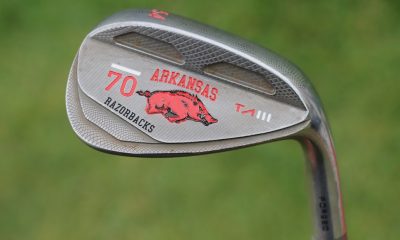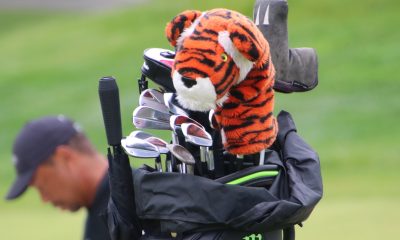Instruction
Don’t be a golfer who doesn’t improve

I had an interesting thought while watching a PGA Tour tournament the other day: A manufacturer’s advertisement stated that over the last 20 years or so, the average handicap has not gone down, yet we have better equipment and better teaching technology. However, if you hit this club, everything would all change (how nice it would be if just a club could really make all the difference).
The question I pondered was if the equipment is better (it is) and teaching equipment is better (it is), then why do people not improve more quickly or at all? The answer lies not in the equipment used (to a point) or the information given by the instructor (hopefully it is sound). Rather, it lies in the application as to what is practiced — how the student applies the information given during the lesson in subsequent trips to the practice tee itself.
In this article, I will give you several quick tips in applying the given information, no matter what it is, to your own game so you can learn as quickly as possible.
Use a mirror to audit correct/incorrect motions so you can see them visually and feel them kinesthetically!
The first thing I tell my students to do after a lesson is spend some quality time in front of a mirror looking at the differences between the old/incorrect movements versus the correct/new feeling movements. They will feel different and will also look different in the mirror. It is up to students to figure out what exactly makes them perform the correct move versus the incorrect move in the mirror.
Here is why students have to do some of this process on their own — instructors can’t tell you what you feel, and can only go by what they are told by others making the same move or what they felt personally. They are not in your body, so they probably have no clue as to what you are feeling. But they can show you where you should be and tell you biomechanically and physiologically how your body makes the motion in question.
The real key is to make sure you can see and feel the different motion that you have been asked to perform by your teaching professional.
On the practice tee, use small stop-action swings hitting balls off of a tee that only fly between 30 to 60 yards.
Once golfers can see and feel kinesthetically what they are trying to do, it is time for them to try and hit balls using the same motion. But it is still too early to use full swings, even at partial speed.
That’s why I suggest that my students use short iron stop-action swings, hitting small pitch shots feeling the correct move versus the incorrect one. If golfers can identify if they are in the correct/more fundamentally solid position and can visually verify it through the stopping motion, they are ready to move into slow motion swings. But they should only do so once they have mastered this step and can perform it at least 90 percent of the time without too much mental or physical strain.
On the practice tee, make slow motion swings with the ball on a tee trying to feel the same (correct vs. incorrect) motion identified above.
If a golfer has identified the stop-action feeling of what they are trying to do, it is up to them to re-configure their full swing motion to integrate the new and more correct motion. It is here that I suggest using small, slow-motion swings with a short to mid iron using a tee so that they can focus on mechanics rather than ball flight. This step will allow golfers to hit slow motion full-length swings producing ball flights one-quarter of their normal distance so that they can feel what they are trying to do kinesthetically.
If golfers make full-speed swings right away, they will do little good because most golfers go back to what feels normal right away. Rmember, there will be plenty of time to hit full-speed shots later.
As golfers become more proficient at slow-motion swings, they should build up their swing speed up notch by notch until they are moving at full speed again with mid to long irons. When they can make slow-motion swings with those clubs at least 70 percent of the time correctly, then they are ready to move to the long irons and woods at partial speed.
Hit the long irons and woods at partial speed (working up to full speed) along with the small, slow motion pitch shots with the short irons.
Integrating the longer clubs to a new swing feels impossible sometimes, which is why I suggest curing this “latency” by switching back and forth between the long clubs and the short slow-motion pitch shot swings of the short irons. This way, golfers can feel with no doubt the difference between these motions. The long clubs will feel different and will react differently to your changes, but remember that the fundamentals are the same.
Master this drill before moving to full speed swings with all clubs.
If you find yourself slipping back into the same swing flaws, go back to short swings!
Golfers tend to do the same things wrong from now until the end of time, so if and when they fall back into their same swing flaws, they should just repeat the steps above and they should find their way again.
It’s tempting for golfers to go start practicing a new move without trying the steps above again, assuming the new move doesn’t work. But remember, golfers fall back into their old habits 90 percent of the time — guaranteed!
These steps are not fun nor are they anything but boring, but these are the proven motor learning steps to improve — no one is exempt from these steps, some people just move through them quicker than others!
- LIKE3
- LEGIT0
- WOW0
- LOL0
- IDHT0
- FLOP0
- OB0
- SHANK0
Instruction
Clement: Laid-off or perfect fade? Across-the-line or perfect draw?

Some call the image on the left laid off, but if you are hitting a fade, this could be a perfect backswing for it! Same for across the line for a draw! Stop racking your brain with perceived mistakes and simply match backswing to shot shape!
- LIKE1
- LEGIT0
- WOW0
- LOL0
- IDHT0
- FLOP0
- OB0
- SHANK1
Instruction
The Wedge Guy: The easiest-to-learn golf basic

My golf learning began with this simple fact – if you don’t have a fundamentally sound hold on the golf club, it is practically impossible for your body to execute a fundamentally sound golf swing. I’m still a big believer that the golf swing is much easier to execute if you begin with the proper hold on the club.
As you might imagine, I come into contact with hundreds of golfers of all skill levels. And it is very rare to see a good player with a bad hold on the golf club. There are some exceptions, for sure, but they are very few and very far between, and they typically have beat so many balls with their poor grip that they’ve found a way to work around it.
The reality of biophysics is that the body moves only in certain ways – and the particulars of the way you hold the golf club can totally prevent a sound swing motion that allows the club to release properly through the impact zone. The wonderful thing is that anyone can learn how to put a fundamentally sound hold on the golf club, and you can practice it anywhere your hands are not otherwise engaged, like watching TV or just sitting and relaxing.
Whether you prefer an overlap, interlock or full-finger (not baseball!) grip on the club, the same fundamentals apply. Here are the major grip faults I see most often, in the order of the frequency:
Mis-aligned hands
By this I mean that the palms of the two hands are not parallel to each other. Too many golfers have a weak left hand and strong right, or vice versa. The easiest way to learn how to hold the club with your palms aligned properly is to grip a plain wooden ruler or yardstick. It forces the hands to align properly and shows you how that feels. If you grip and re-grip a yardstick several times, then grip a club, you’ll see that the learning curve is almost immediate.
The position of the grip in the upper/left hand
I also observe many golfers who have the butt of the grip too far into the heel pad of the upper hand (the left hand for right-handed players). It’s amazing how much easier it is to release the club through the ball if even 1/4-1/2″ of the butt is beyond the left heel pad. Try this yourself to see what I mean. Swing the club freely with just your left hand and notice the difference in its release from when you hold it at the end of the grip, versus gripping down even a half inch.
To help you really understand how this works, go to the range and hit shots with your five-iron gripped down a full inch to make the club the same length as your seven-iron. You will probably see an amazing shot shape difference, and likely not see as much distance loss as you would expect.
Too much lower (right) hand on the club
It seems like almost all golfers of 8-10 handicap or higher have the club too far into the palm of the lower hand, because that feels “good” if you are trying to control the path of the clubhead to the ball. But the golf swing is not an effort to hit at the ball – it is a swing of the club. The proper hold on the club has the grip underneath the pad at the base of the fingers. This will likely feel “weak” to you — like you cannot control the club like that. EXACTLY. You should not be trying to control the club with your lower/master hand.
Gripping too tightly
Nearly all golfers hold the club too tightly, which tenses up the forearms and prevents a proper release of the club through impact. In order for the club to move back and through properly, you must feel that the club is controlled by the last three fingers of the upper hand, and the middle two fingers of the lower hand. If you engage your thumbs and forefingers in “holding” the club, the result will almost always be a grip that is too tight. Try this for yourself. Hold the club in your upper hand only, and squeeze firmly with just the last three fingers, with the forefinger and thumb off the club entirely. You have good control, but your forearms are not tense. Then begin to squeeze down with your thumb and forefinger and observe the tensing of the entire forearm. This is the way we are made, so the key to preventing tenseness in the arms is to hold the club very lightly with the “pinchers” — the thumbs and forefingers.
So, those are what I believe are the four fundamentals of a good grip. Anyone can learn them in their home or office very quickly. There is no easier way to improve your ball striking consistency and add distance than giving more attention to the way you hold the golf club.
More from the Wedge Guy
- The Wedge Guy: Golf mastery begins with your wedge game
- The Wedge Guy: Why golf is 20 times harder than brain surgery
- The Wedge Guy: Musings on the golf ball rollback
- LIKE88
- LEGIT15
- WOW6
- LOL1
- IDHT0
- FLOP4
- OB1
- SHANK9
Instruction
Clement: Stop ripping off your swing with this drill!

Not the dreaded headcover under the armpit drill! As if your body is defective and can’t function by itself! Have you seen how incredible the human machine is with all the incredible feats of agility all kinds of athletes are accomplishing? You think your body is so defective (the good Lord is laughing his head off at you) that it needs a headcover tucked under the armpit so you can swing like T-Rex?
- LIKE0
- LEGIT3
- WOW2
- LOL0
- IDHT0
- FLOP0
- OB0
- SHANK2
-

 19th Hole3 weeks ago
19th Hole3 weeks agoLET pro gives detailed financial breakdown of first week on tour…and the net result may shock you
-

 19th Hole1 week ago
19th Hole1 week agoReport: LIV star turns down PGA Championship invite due to ‘personal commitments’
-

 19th Hole2 weeks ago
19th Hole2 weeks agoGary Player claims this is what ‘completely ruined’ Tiger Woods’ career
-

 Equipment1 week ago
Equipment1 week agoDetails on Justin Thomas’ driver switch at the Wells Fargo Championship
-

 Whats in the Bag2 weeks ago
Whats in the Bag2 weeks agoTeam McIlowry (Rory McIlroy, Shane Lowry) winning WITBs: 2024 Zurich Classic
-

 Whats in the Bag1 week ago
Whats in the Bag1 week agoKeegan Bradley WITB 2024 (May)
-

 Equipment2 weeks ago
Equipment2 weeks agoGolf fans left surprised by LIV’s choice of course for its 2024 individual championship event
-

 Whats in the Bag3 days ago
Whats in the Bag3 days agoRory McIlroy’s winning WITB: 2024 Wells Fargo Championship





















Scott
Aug 25, 2013 at 10:48 am
I agree with the techniques described in the article. But it is difficult to for the average Joe taking lessons to be working at half speed or slower on the practice tee (limited practice time) while still playing in his league or foursome at full speed (also limited time). I’ve always had trouble with this mix – – it takes alot of time and dedication to truly get better.
Regis
Aug 20, 2013 at 6:15 pm
I think the reason that handicaps stay the same despite advances in equipment is that the average golfer ages. My group and I started playing together when in our 40’s. On Average we were 12-15 handicaps. Now we’re in our 60’s and have seen our drives drop from the 240 range to the 200 range. We’re now in the 15-18 range. Same course and tees. Love to see stats on how the average age of avid golfers has changed over the years
Mic
Aug 20, 2013 at 3:59 pm
Meh- play the game for fun and enjoy being outside. Game improvement is overrated.
Duane
Aug 31, 2013 at 7:20 pm
Playing the game well is more enjoyable for you and the group behind you. Nothing wrong with game improvement IMO.
larrybud
Aug 19, 2013 at 11:37 am
The reason reason why people don’t improve is that 99.9% of the people who play golf don’t practice at *all*, and those who do don’t know what to practice.
The casual golfer does NOT take lessons. Out of 40 guys on my 2 leagues, I know of just 2 others who have taken lessons at one time or another.
BH
Aug 19, 2013 at 1:06 pm
Bingo.
Nick
Aug 20, 2013 at 12:10 pm
BH has already given this the seal of approval but this is it. When I first decided to “get serious” about golf I beat balls on the range till my hands got torn up. I saw virtually no improvement (predictably) over six months. It wasn’t until I started getting professional instruction so that my practice was geared towards improving diagnosed swing flaws (and putting and short game flaws) as opposed to “finding the secret in the dirt” that I started to see my scores and handicap improve on a sustained downward trend.
Scott Shields
Aug 19, 2013 at 11:22 am
Basic motion and Aquired motion swings. Best for practice and improvment.